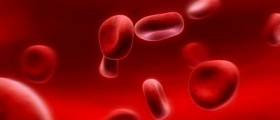What is Leukemia?
It is due to excessive abnormal production of white blood cells (leukocytes) inside the bone marrow. Bone marrow is responsible for the production of blood cells such as red blood cells, white blood cells, platelets, etc. which is controlled by a special mechanism in human body. Due to some reasons, bone marrow may begin producing excessive blood cells resulting in blood cancer.

Types of Leukemia
There are several types of leukemia but the most common types of leukemia are:
- Acute lymphoblastic leukemia - ALL
- Acute myelogenous leukemia - AML
- Chronic myelogenous leukemia - CML
- Chronic lymphocytic leukemia - CLL
- Hairy cell leukemia - HCL
Each type has its own presentation - signs, symptoms, diagnostic criteria, treatment, complications, etc. However, sometimes it may be difficult to differentiate between two types.
Symptoms of Leukemia
Each type of leukemia has its typical symptoms, yet there are some symptoms that are common in almost all individuals suffering from leukemia. The common symptoms of leukemia depend on the blood cell that is involved. Given below are the symptoms of leukemia according to the blood cells involved.
Abnormal red blood cells may cause:
- Fatigue,
- Difficulty in breathing,
- Feeling of sickness,
- Easy bruising
White blood cells play an important role in strengthening body's immune system. Immature or abnormal white blood cells can cause following symptoms:
- Fever
- Recurrent infections (respiratory infections and urinary tract infections are commonly seen)
- Chills
- Night sweats
- Flu-like symptoms
Platelets perform an important role in clotting of blood. Abnormal or decreased number of platelet can cause bleeding and petechiae (pin-prick bleeds on skin). The bleeding can occur from any site like gums, nose, joints, a minor injury, surgical cuts, etc.
Is Leukemia Hereditary?
Leukemia itself is not a hereditary disease. However, people who have a family history of leukemia are prone to develop this disorder and thus are tested regularly.
Screening of Leukemia - find out if you're on the safe side
If you are suspicious to find out whether you have leukemia or not, you can simply go for a regular "Complete Blood Count (CBC)" test and "Blood Smears". Keep in mind that there is no approved test for screening of leukemia but these tests help the doctor to find out if there is something suspicious going on in your blood system.
Diagnosis of Leukemia
Many tests are performed in the patients who are suspected to have leukemia. "Complete blood cell count (CBC)" and "peripheral blood smears" are the initial diagnostic tests. CBC may show elevated or low number of red blood cells, white blood cells, or platelets.
Bone marrow biopsy and lymph node biopsy are the definitive tests that are used to confirm the diagnosis of leukemia.
Treatment and Prevention
The treatment depends on the type and stage of the disease. CML is the most common type found in adults typically between 20 to 40 years.
There are no specific measures for the prevention of leukemia.
- Photo courtesy of SteadyHealth















